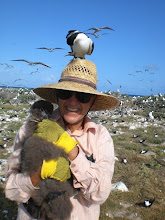
Tuesday, March 31, 2009
Sunday, March 29, 2009
Bonin Petrel Chick




There are about 100,000 Bonin Petrels nests on Midway. Like the Tropicbirds they spend their entire lives at sea except to breed and nest on oceanic islands such as Midway. They nest in burrows and one usually doesn't get good looks at the chicks. This one I found under the concrete debris while I was photographing the Red-tailed Tropicbirds and it's a little larger than a baseball.
Red-tailed Tropicbird





One of the sea birds that I work with regularly is Red-tailed Tropicbird. It lives all of it's life at sea except to come ashore to breed and lay eggs. I monitor a plot that contains 5 Tropicbird nests at his time and will have many more before I leave Midway. I note the date the nest was found and tip the bird to check for an egg and whether it is banded or not. If it is not banded we band the bird and replace it on the nest. Sometimes this is easier in theory than in practice. Once we know the band number of any adult we put a drop of nail polish on it's head so we know it is banded and don't need to disturb it again. As the chicks get older we we also band them. Each of these nests will be monitored through their whole nesting cycle and at the end of the season a percentage of nesting success can be generated by using the figures for failed and successful nests. Here are pictures of nesting Red-tailed Tropicbirds sitting on their nests in the rubble of an old concrete wall.
Saturday, March 28, 2009
Shade in the Afternoon



Both of the albatross species nesting on Midway usually nest in wide open spaces with no trees and only a few bushes. Even with this in mind the albatross seem to instinctually seek shade on warm afternoons. Today is about 73 degrees and 73% humidity so cool by Oroville standards but it does feel warm out in the sun.
Wednesday, March 25, 2009
Kahana




We had a small container ship come in this morning to resupply the island. There were 6 containers plus fuel, which is being unloaded now, 12 hours after the ship arrived. The containers are lifted off the ship and emptied and then are refilled with recyclables for the ship to take back to Honolulu. In these pictures the containers are back on board but the fuel is still being pumped into the tank truck that stays here on the Midway. The truck then drives a short distance and the fuel is pumped into permanent tanks here on the island. Work permitting we may get on board the Kahana tomorrow morning before it sails at Noon. I can't give you much detail about the pictures but here they are.
Bicycling Sunday Morning
Traffic Jam on My Way to Breakfast
On my way to breakfast this morning there was a traffic jam in front of Bravo barracks. There were 2 golf carts unable to move because one of our new visitors from a photography group was sitting in the middle of the road getting a picture of an albatross. He was totally oblivious to the chaos he was creating in the traffic flow. Two golf carts stopped in the same spot was noteworthy though.
Sunday, March 22, 2009
Laysan Ducks on Midway




This morning I spent nearly 4 hours with Dr. Michelle Reynolds, the scientist working on the newly introduced population of Laysan Ducks here on Midway. The duck was introduced here to give them a better chance of survival, as the only population had been on Laysan Island south and east of here. With 2 separate populations the bird has a better chance to survive a catastrophic storm or a disease outbreak. The first birds were trans located here in 2004 and have done well even with a major disease outbreak. The total world population of this duck is probably still less than 1,000 birds and this small number plus its very restricted range have placed it on the Federal Endangered Species list. We successfully captured and banded 3 unbanded birds this morning. Banding a large part of the population allows scientists to develop an index that will make it possible to accurately estimate the size of the population. It was exciting to hold a bird this rare and to make the very small contribution of a morning's work toward its survival. The pictures that accompany this post show several views of the Laysan Duck population and me holding one in preparation for its release.
Saturday, March 21, 2009
Wednesday, March 18, 2009
Hydroponic Garden





The garden is inside a shade cloth structure so the birds are not an issue. The small tubing delivers a water and nutrient mix to a trough and the plants are suspended above the trough so their roots are submerged. The trough is sloped slightly so the nutrient mix flows down hill and what the plants don't take up runs out the other end and is collected and run through again. Many types of leafy vegetables are grown and the garden produces about 30 pounds a week.
Subscribe to:
Comments (Atom)


























